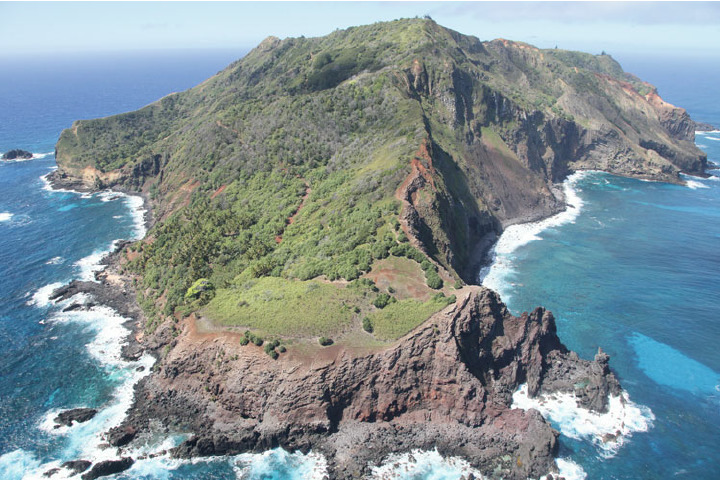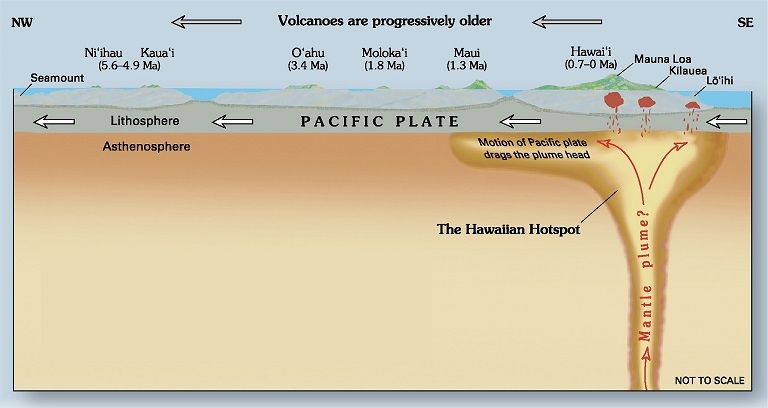Welcome to the Pitcairn Hotspot - you are probably really far away from home!
The Pitcairn hotspot has played a significant role in shaping the geological landscape of the south-central Pacific Ocean over millions of years. This earthcache explains what hotspots are and how you can see the volcanic origin at the earthcache location.
 Source: https://www.researchgate.net/figure/Pitcairn-Island-viewed-from-the-west-Photo-A-MacDonald_fig2_260655920.
Source: https://www.researchgate.net/figure/Pitcairn-Island-viewed-from-the-west-Photo-A-MacDonald_fig2_260655920.
Volcanic hotspots
Volcanic hotspots are areas of intense volcanic activity that occur independently of tectonic plate boundaries. They are believed to be caused by mantle plumes, which are narrow streams of hot, buoyant rock rising from deep within the Earth's mantle. As the mantle plume rises towards the Earth's surface, it melts through the overlying crust, leading to volcanic eruptions and the formation of volcanic features such as islands, seamounts, and rift zones.
Here are some key points about volcanic hotspots:
-
Mantle Plumes: Hotspots are often associated with mantle plumes, which are thought to originate from the boundary between the Earth's core and mantle. These plumes consist of hot, buoyant material that rises through the mantle, reaching the Earth's crust and causing volcanic activity when they intersect with it.
-
Island Chains and Trails: Volcanic hotspots often leave behind trails of volcanic activity as tectonic plates move over them. This results in the formation of island chains or seamount chains, with the youngest volcanic activity occurring at the hotspot itself and progressively older volcanic features extending away from it.
-
Formation of Islands and Seamounts: Hotspots can create a variety of geological features, including volcanic islands, seamounts (underwater mountains), and even atolls (ring-shaped coral reefs). The type of feature formed depends on factors such as the depth of the oceanic crust and the rate of volcanic activity.
-
Examples of Hotspots: Some well-known volcanic hotspots include the Hawaii hotspot (responsible for the formation of the Hawaiian Islands), the Yellowstone hotspot (associated with the Yellowstone supervolcano), and the Iceland hotspot (which created the volcanic island of Iceland).
The picture below describes the creation of islands close to a hotspot (example: Hawaii):
 Source: https://en.wikipedia.org/wiki/Hotspot_(geology)#/media/File:Hawaii_hotspot_cross-sectional_diagram.jpg
Source: https://en.wikipedia.org/wiki/Hotspot_(geology)#/media/File:Hawaii_hotspot_cross-sectional_diagram.jpg
Composition of hotspot volcanoes
Most hotspot volcanoes, like those found in Hawaii and Tahiti, are characterized by basaltic magma, which tends to produce relatively non-explosive eruptions compared to volcanoes at subduction zones where water is trapped beneath the overriding plate. However, when hotspots occur in continental regions, the rising basaltic magma can interact with the continental crust, resulting in the formation of more explosive eruptions. Interestingly, once the magma is fully erupted, the volcanic activity causes basalt coming from eruptions and lava flows.
Basalt
Basalt is a dark-colored igneous rock with a predominantly fine-grained texture, often appearing black or dark gray. Its surface may exhibit small, visible mineral grains, but they are generally too small to distinguish with the naked eye. When polished, basalt often showcases a smooth and shiny surface. In terms of its physical appearance, basalt can vary slightly depending on its specific mineral composition and the conditions under which it formed. However, overall, it presents a uniform and often somewhat lustrous appearance, making it easily recognizable as a dark, dense rock.. It's composed mainly of feldspar and pyroxene minerals. Basaltic lava is low in silica, making it fluid and able to flow long distances.

Source: own picture
Pitcairn Hotspot - birth of the Pitcairn islands
The Pitcairn hotspot, situated in the south-central Pacific Ocean, has been active for the past 11 million years, giving rise to the Pitcairn-Gambier hotspot chain. This volcanic activity has led to the formation of various geological features, including the Pitcairn Islands, as well as two substantial seamounts named Adams and Bounty, along with atolls such as Moruroa, Fangataufa, and the Gambier Islands. Presently, the hotspot is centered around Adams and Bounty, approximately 60 kilometers East-Southeast of Pitcairn Island. The hotspot has formed a chain of seamounts over the past 11 million years with several other large seamounts along the chain as well, organized from older to younger the further east you go. Some of these islands make up the Pitcairn Islands.
In order to log this earthcache you must visit the earthcache location and answer the following questions:
1) Do you see evidence at the earthcache location that the Pitcairn islands were created by non-explosive eruptions from the Pitcairn hotspot?
2) In front of you, you see a high rock where the path goes up to the main road. Have a close look at the rock and compare its properties to the description of basalt in the earthcache listing. Could this rock be basalt? What makes you think it is or it is not?
3) Please upload a non-spoiler picture to prove that you have been on-site. A picture of you/your group showing your GPS receiver or your Geocaching nickname is mandatory. The high rock must be in the background.
As soon as you have sent the answer via the messenger or email, you can log the cache. Logs without answering the questions will be deleted without prior notice.
Happy earthcaching!
Source:
https://en.wikipedia.org/wiki/Pitcairn_hotspot
https://en.wikipedia.org/wiki/Hotspot_(geology)
https://geoworldtraveldiaries.com/2015/11/27/adventures-and-geology-in-the-pitcairn-islands/
https://www.sciencedirect.com/science/article/abs/pii/S0024406685700521